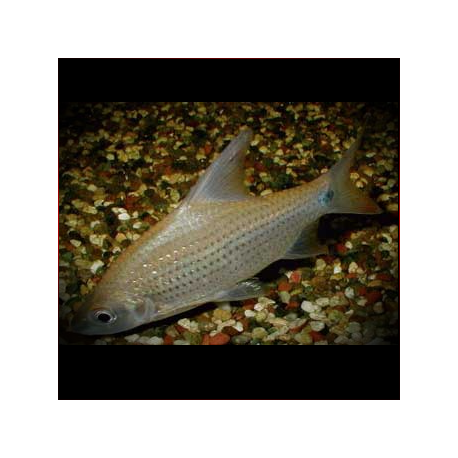Cyclocheilichthys Apogon
Cypriniformes Print
More info
Datasheet
| Minimum Tank Size | 370 litres / 97.74 US gallons |
| Maximum Size | 18.0cm / 7.09inches |
| Temperature | 20°C / 68.00°F - 27°C / 80.60°F |
| Hardness | 1.01dgH / 18ppm - 20.00dgH / 357ppm |
| pH | 5.5-8.0 |
General Description
The Cyclocheilichthys Apogon, commonly known as the Beardless Barb, is a peaceful and unique addition to larger aquarium setups. This fish, sometimes referred to as the 'skinhead barb' in the aquarium trade, lacks barbels and is distinguished by a black blotch at the base of the caudal fin and rows of dark spots along its lateral scale rows. It belongs to the Cyprinidae family and prefers a dimly-lit environment with a soft sand substrate and driftwood for shady patches.
Aquarium Setup
For optimal care, a tank of at least 370 litres should be provided with a soft sand substrate and dim lighting. Driftwood pieces should be added to create shade, and some aquatic plants such as Microsorum, Taxiphyllum, or potted Cryptocorynes species can be included. Floating vegetation patches can help to diffuse light and provide a more natural environment. Water conditions should be maintained with a pH of 5.5-8.0, hardness of 18-357 ppm, and a temperature range of 20-27°C.
Behaviour
The Beardless Barb is a gregarious species that thrives in groups of at least six individuals. When kept with conspecifics, they display better coloration, become less nervous, and exhibit a more natural behavior. In a community tank, large adults of this species may intimidate slow-moving or timid companions, so suitable tankmates include cyprinids, loaches, cichlids, catfish, and characins.
Feeding and Diet
In their natural habitat, Beardless Barbs primarily feed on micropredatory items like insects, crustaceans, and fry. To ensure their optimal health in captivity, a diet of small live and frozen foods such as bloodworms, Daphnia, and Artemia should be offered regularly. Additionally, high-quality dried flakes and granules can be given to supplement their diet.
Reproduction & Dimorphism
There have been no reported instances of breeding Cyclocheilichthys Apogon in captivity; however, in the wild, they spawn in flooded zones towards the end of the wet season. Sexually mature females are typically thicker-bodied than males, exhibiting slight sexual dimorphism.
Habitat and Distribution
These fish are primarily found in riverine environments, favoring slower-moving or still zones with submerged tree roots, branches, and plants. They are native to a vast range extending from Myanmar to Vietnam and southwards through Peninsular Malaysia to Borneo and Sumatra. Cyclocheilichthys Apogon is also found in various lakes, reservoirs, and artificial water bodies due to human interference.

